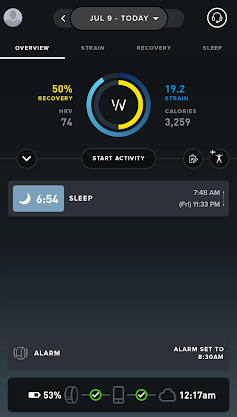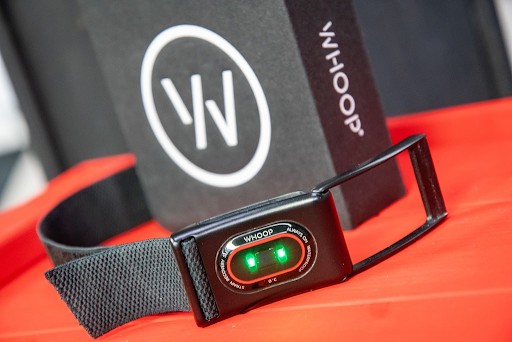Welcome back to Gear Review; we will discuss my review on Whoop 4.0.
How does the Whoop work?
I just received my Whoop, and my initial reaction was that this device was not a watch but more of a recovery monitor. The device casing feels dense and heavy, but for its size, it’s relatively small. The band is very comfortable and flexible; the clasp gives it a secure fit. I enjoyed that since some devices always fall off when moving or doing an activity.
The device has four biometric sensors at the bottom that can detect SpO2 levels, skin temperature, heart rate, and respiratory rate. The optical sensors are LED lights that use green, red, and infrared. These colors help pick up metrics such as heart rate through photoplethysmography (PPG), which is a non-invasive technology that uses a light source and photodetector at the surface of the skin to measure the volume of variations in blood circulations. Instead of measuring heart rate, the red light flashes into the skin, which helps pick up the estimated amount of oxygen circulating in the body. The Whoop also has a haptic touch, a vibration mechanism. It will vibrate to tell you if you have reached your goal, or can be set as an alarm to wake you up.
Who is it for?
The Whoop is for those who want to take control of their workouts and recovery. It is is unlike the Apple Watch, Fitbit, or any other wearable device. Instead of being a calorie and step tracker, it acts as an information hub for those who crave more in-depth data. The Whoop follows how much effort you put into your training, and estimates how ready you are for your next workout based on recovery and how hard you train.
On my training days, I noticed some days were better than others. The strain performance meter gave me an excellent in-depth value of where I was on my readiness level for exercise. This device helped me overcome some hard training days and also helped me prepare for recovery days. The biggest takeaway is that this device is only for recovery and strain control that can help get you back into training even though you may be sore.


Final Thoughts
All in all, the Whoop is a beneficial device to get you back on track based on your recovery. It can help estimate when you will hit a plateau in your training and help avoid overtraining and undertraining, which is a crucial factor when not seeing muscle development and weight loss. The Whoop has a subscription-based platform, though, which will cost more than the device itself for a whole year. But, it will be beneficial for recovery.
Next month, we will be looking at another device, the Garmin. Thank you all for taking the time to read this blog. See you next month.



